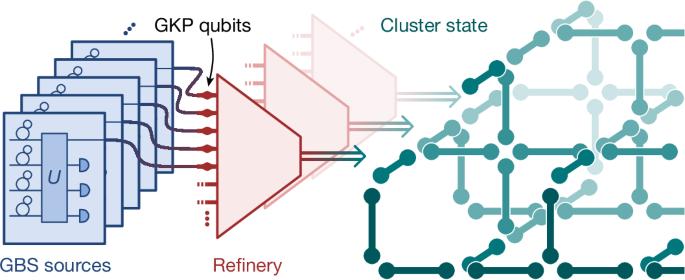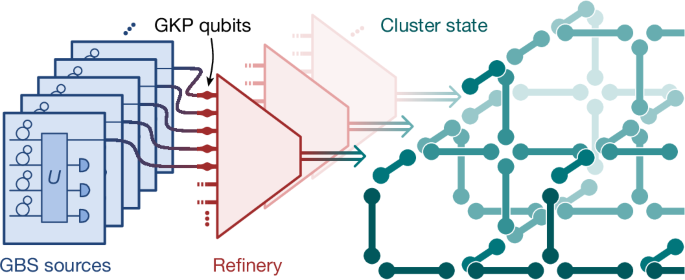Gottesman-Kitaev-Preskill量子比特的集成光子源
IF 48.5
1区 综合性期刊
Q1 MULTIDISCIPLINARY SCIENCES
引用次数: 0
摘要
建立一个有用的光子量子计算机需要强大的技术来合成可以编码量子比特的光态。Gottesman-Kitaev-Preskill (GKP)态1提供了此类量子比特编码中最具吸引力的一类,因为它们使通用门集的实现具有直接、确定性和室温兼容的高斯操作2。现有的产生光学GKP态3和其他复杂非高斯态4、5、6、7、8、9、10、11的开创性演示依赖于自由空间光学元件,阻碍了最终实现实用规模系统所需的缩放。在这里,我们使用在定制的多层氮化硅300毫米晶圆平台上制造的超低损耗集成光子芯片,通过光纤与高效光子数分辨探测器耦合,产生GKP量子比特态。这些状态显示了容错所必需的关键模式级特征,包括p和q正交中至少四个可分辨的峰,以及负Wigner函数区域的清晰晶格结构,在这种情况下是一个3 × 3网格。我们还表明,我们的GKP状态显示出足够的结构,表明用于制造它们的设备可以在进一步降低光损耗后,产生容错状态。这个实验验证了光子量子计算的玻色子架构的一个关键支柱,为将来提供容错机器的GKP源阵列铺平了道路。本文章由计算机程序翻译,如有差异,请以英文原文为准。


Integrated photonic source of Gottesman–Kitaev–Preskill qubits
Building a useful photonic quantum computer requires robust techniques to synthesize optical states that can encode qubits. Gottesman–Kitaev–Preskill (GKP) states1 offer one of the most attractive classes of such qubit encodings, as they enable the implementation of universal gate sets with straightforward, deterministic and room temperature-compatible Gaussian operations2. Existing pioneering demonstrations generating optical GKP states3 and other complex non-Gaussian states4–11 have relied on free-space optical components, hindering the scaling eventually required for a utility-scale system. Here we use an ultra-low-loss integrated photonic chip fabricated on a customized multilayer silicon nitride 300-mm wafer platform, coupled over fibre with high-efficiency photon number resolving detectors, to generate GKP qubit states. These states show critical mode-level features necessary for fault tolerance, including at least four resolvable peaks in both p and q quadratures, and a clear lattice structure of negative Wigner function regions, in this case a 3 × 3 grid. We also show that our GKP states show sufficient structure to indicate that the devices used to make them could, after further reduction in optical losses, yield states for the fault-tolerant regime. This experiment validates a key pillar of bosonic architectures for photonic quantum computing2,12, paving the way for arrays of GKP sources that will supply future fault-tolerant machines. An ultra-low-loss integrated photonic chip fabricated on a customized multilayer silicon nitride 300-mm wafer platform, coupled over fibre with high-efficiency photon number resolving detectors, is used to generate Gottesman–Kitaev–Preskill qubit states.
求助全文
通过发布文献求助,成功后即可免费获取论文全文。
去求助
来源期刊

Nature
综合性期刊-综合性期刊
CiteScore
90.00
自引率
1.20%
发文量
3652
审稿时长
3 months
期刊介绍:
Nature is a prestigious international journal that publishes peer-reviewed research in various scientific and technological fields. The selection of articles is based on criteria such as originality, importance, interdisciplinary relevance, timeliness, accessibility, elegance, and surprising conclusions. In addition to showcasing significant scientific advances, Nature delivers rapid, authoritative, insightful news, and interpretation of current and upcoming trends impacting science, scientists, and the broader public. The journal serves a dual purpose: firstly, to promptly share noteworthy scientific advances and foster discussions among scientists, and secondly, to ensure the swift dissemination of scientific results globally, emphasizing their significance for knowledge, culture, and daily life.
 求助内容:
求助内容: 应助结果提醒方式:
应助结果提醒方式:


